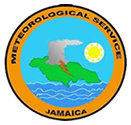The cold fronts, usually weak after migrating from the North American continent, are evident from mid-October to mid-April; whilst the Tropical Weather Systems, namely Tropical Waves, Tropical Depressions, Tropical Storms and Hurricanes occur from April to December. The official hurricane season is from June to November.
The national Meteorological Service in Jamaica maintains close communication with the US National Hurricane Centre especially during the hurricane season, thereby ensuring the timely dissemination of forecasts and warni
is concerned with the observation and forecasting of weather conditions over and around the island.
It consists of a Radar Section that closely monitors and reports on rainfall occurrence within a range of nearly 500 kilometres;
A Doppler radar is a specialized radar that uses the Doppler effect to produce velocity data about objects at a distance. It does this by bouncing a microwave signal off a desired target and analyzing how the object’s motion has altered the frequency of the returned signal. This variation gives direct and highly accurate measurements of the radial component of a target’s velocity relative to the radar. Doppler radars are used in aviation, sounding satellites, meteorology, radar guns,[1] radiology and healthcare (fall detection [2] and risk assessment, nursing, or clinic purpose [3]), and bistatic radar (surface-to-air missile).
Partly because of its common use by television meteorologists in on-air weather reporting, the specific term “Doppler Radar” has erroneously become popularly synonymous with the type of radar used in meteorology. Most modern weather radars use the pulse-doppler technique to examine the motion of precipitation, but it is only a part of the processing of their data. So, while these radars use a highly specialized form of doppler radar, the term is much broader in its meaning and its applications.

A branch of the Ministry Economic Growth and Job Creation (MEGJC)